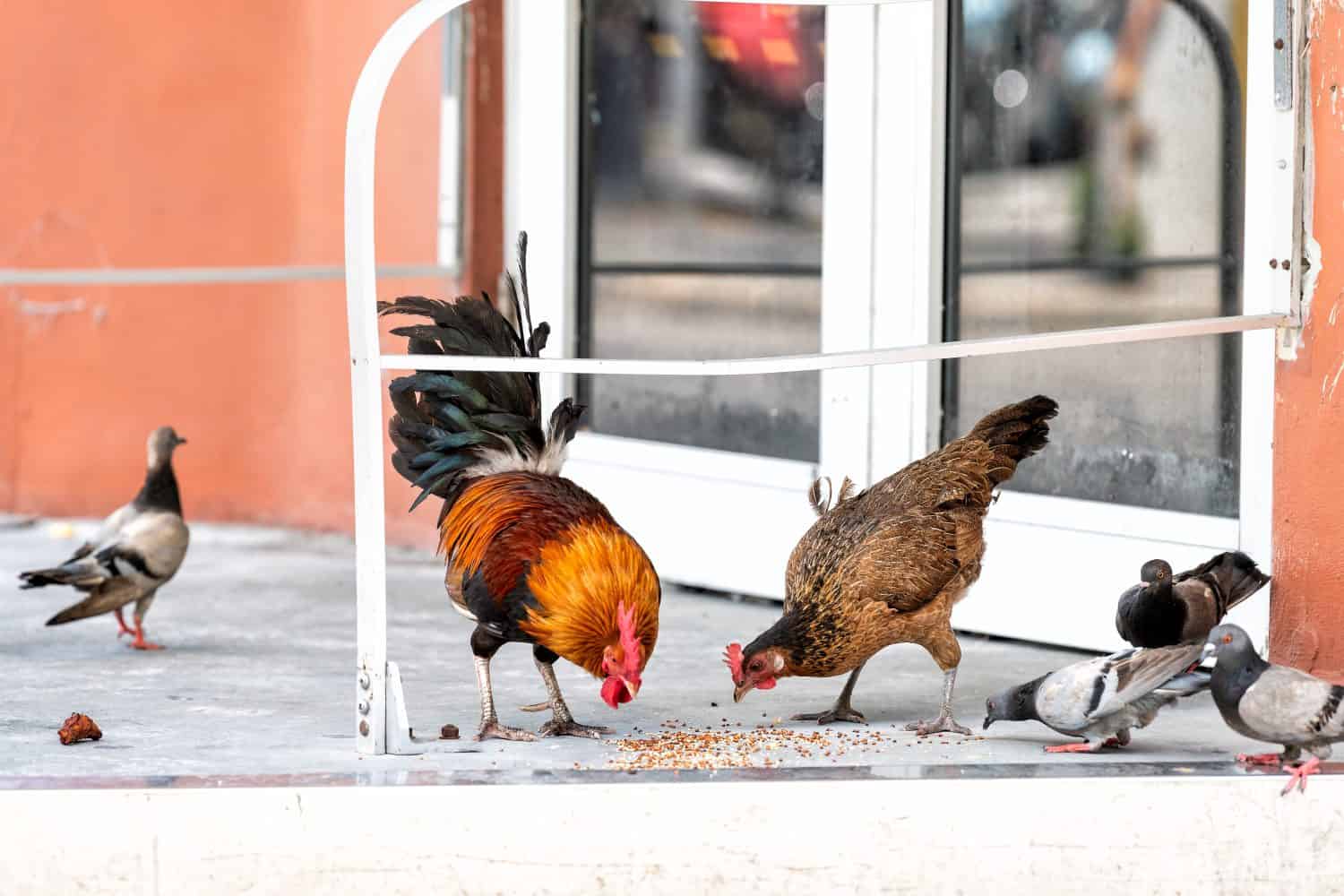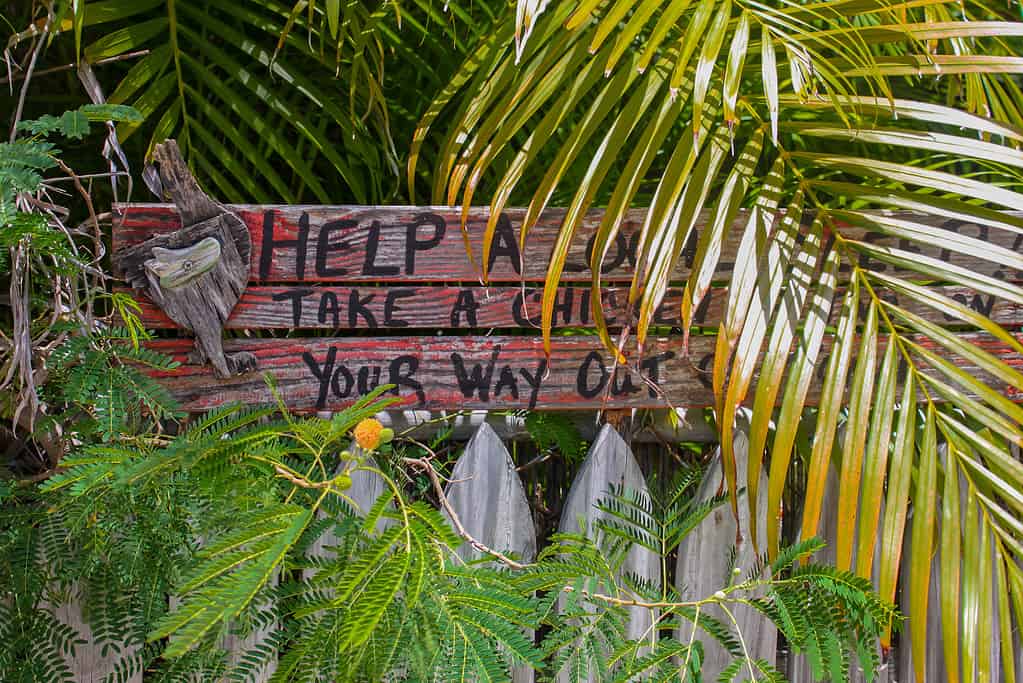Key West is a tropical paradise, a romantic getaway for couples, and a … chicken sanctuary. That’s right — Key West is home to a large population of feral chickens. However, these particular chickens are largely friendly despite being “wild.”
If you find yourself in this popular vacation spot, enjoying local culture and taking in the scenery, you may spot several chickens crossing the roads. That’s when you may ask yourself a common question (not “Why did the chicken cross the road?”) — why do chickens roam freely around Key West? Read on to discover where these chickens came from, why they’re all over the island, and what people think about it.
Where Did These Chickens Come From?

Even though locals are accustomed to these free-roaming chickens, Key West visitors are often taken aback by the sight of so many of them wandering freely around the island.
©edb3_16/iStock via Getty Images
The Key West chickens have been on the island for a long time. Some people theorize that Spanish explorers brought the first chickens to the island in the 1500s. Others believe that Cuban immigrants introduced them to Key West in the 1800s. Either way, the chickens have been roaming around the area for quite some time.
These freewheeling chickens were once an important part of the local economy. Local businesses used their eggs while residents used them as a source of food. On a darker note, the roosters were often exploited in cockfighting rings. Fortunately, people gradually began to recognize the inhumanity of the sport and stopped cockfighting altogether. Roosters and chickens were then released to become the free-roaming birds of today.
Why Do The Chickens Roam Freely Around Key West?

When in Key West, you’ll see chickens in trees, in people’s yards, and even pecking seeds on the porches of businesses.
©Andriy Blokhin/Shutterstock.com
As people stopped needing them for a food source, they were slowly relinquished from their backyard pens. Additionally, when animal welfare proponents finally made cockfighting illegal, those roosters gained their freedom, too. These chickens are often referred to as gypsy chickens by the locals due to their free-spirited wandering.
Chickens are now emblematic tourist attractions in Key West. Not only can you see them all over in “person,” but their likenesses appear on countless souvenirs — from Christmas ornaments to wine stoppers to key chains. For many tourists, chicken encounters are one of the best parts of their Key West experiences.
How Do the Locals Feel About Chickens Roaming Freely Around Key West?

Though meant in a humorous fashion, you may see signs in locals’ yards such as this one that says, “Help a local sleep- Take a chicken with you on your way out of town.”
©Susan Vineyard/iStock via Getty Images
By 2004, the gypsy chicken population had grown to the point where many locals saw them as nuisances. Hence, the city decided to hire a chicken catcher — much like a dog catcher for fowl — to scale down the numbers. Naturally, those locals who were chicken champions were concerned about the fate of the chickens taken into custody. They questioned the chicken catcher to the extent that he ended up quitting after only one year of service.
By 2021, the Key West City Commission tried another tactic to combat the chicken controversy. They instituted a “no-feed” policy for the wild chickens. Currently, there’s also a community trapping program that allows people to humanely trap any chickens who invade their property. These chickens are then brought to the Key West Wildlife Center.
What Happens to Nuisance Chickens at the Wildlife Center?

Veterinarians care for chickens at the Key West Wildlife Center
©Murilo Mazzo/Shutterstock.com
Captured chickens are brought to the Wildlife Center. There, vets care for them, get them healthy if needed, and send them on to local organic farms. At these farms, the chickens supply the farmers with eggs while also serving as organic pest control. They feast on the bugs and worms that would otherwise harm the farmers’ produce. The chickens are never killed or eaten.
The traps that are used to humanely capture the chickens are in high demand on the island. There are so many chickens that residents are on a waiting list to borrow the traps. Key West is a no-kill city, so getting some of them out and onto the organic farms is essential to many of the locals’ comfort. Though they’re a colorful and unique tourist attraction, they can also be noisy and bothersome to people who live with them year-round.
Are Key West Chickens Protected?

Although there are residents who would like to decrease the number of chickens on the island, many locals regard them as an integral part of Key West’s character and allure.
©ablokhin/iStock via Getty Images
Chickens are blessed with abundant protection in Key West. In fact, the Key West Chicken Law ensures that the island continues to boast a healthy gypsy chicken population. Whether a local or a resident, the law prohibits people from harming or killing the island’s chickens.
Key West chickens are cherished as part of the island’s history and culture. They’re also regarded as community members who add value to the overall charm and allure of Key West. In addition to the law prohibiting the harming or killing of these feathered citizens, there is also the 2021 law against feeding them. This law is meant to keep them healthy since people often unintentionally feed them the wrong kinds of food.
Conclusion

Chickens have been in Key West for hundreds of years. With continued protections in place, will hopefully be around for hundreds more.
©Joe Dube/Shutterstock.com
People take vacations in Key West for a number of reasons. The gorgeous weather, bright blue ocean water, and amazing tourist attractions are just a few. However, even with all of the other amenities, a Key West vacation wouldn’t be the same without the sights and sounds of the island’s gypsy chickens wandering in and out of trees, businesses, and local yards… and crossing the streets.
The photo featured at the top of this post is © caseyjadew/Shutterstock.com
Thank you for reading! Have some feedback for us? Contact the AZ Animals editorial team.







